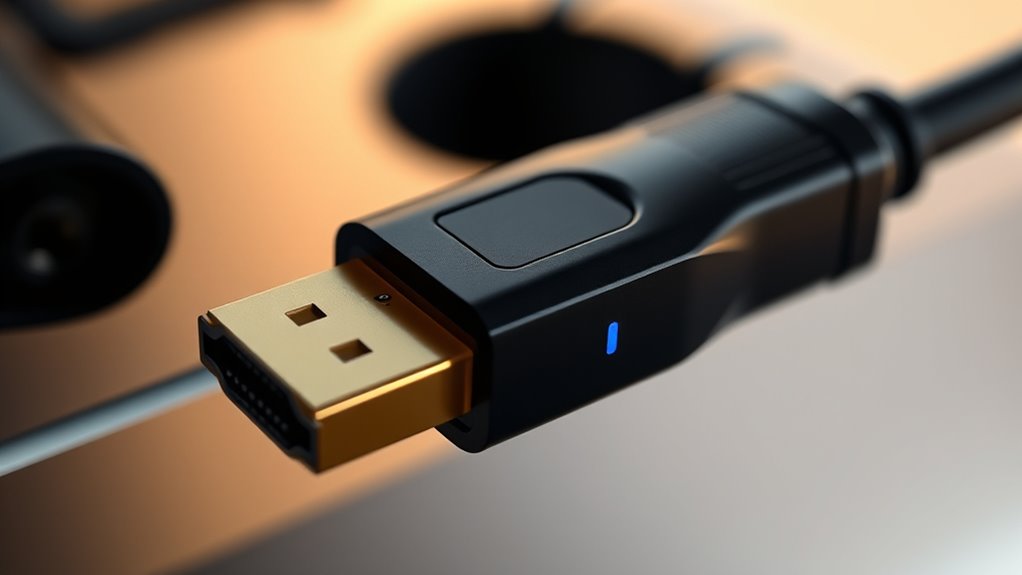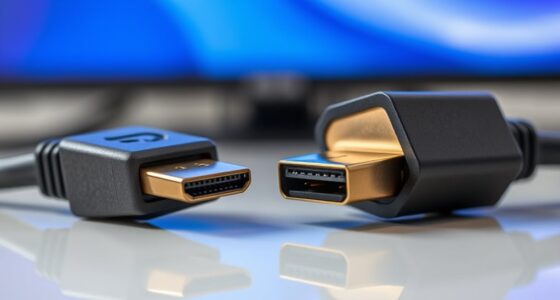HDMI 2.1 boosts your multimedia experience by supporting higher resolutions like 8K at 60Hz and 4K at 120Hz, making your gaming and videos smoother and sharper. It also offers advanced features such as Variable Refresh Rate (VRR) and Auto Low Latency Mode (ALLM), reducing lag, screen tearing, and stuttering. Plus, it improves audio with enhanced return channel (eARC) for immersive sound. If you keep exploring, you’ll discover even more ways HDMI 2.1 upgrades your entertainment setup.
Key Takeaways
- Supports 4K at 120Hz and 8K at 60Hz for high-resolution gaming and video playback.
- Features Variable Refresh Rate (VRR) and Auto Low Latency Mode (ALLM) for smoother gaming.
- Enables high-bitrate audio formats like Dolby Atmos and DTS:X via enhanced eARC.
- Ensures seamless integration of high-quality audio and ultra-high-resolution video.
- Future-proofs devices with support for upcoming multimedia standards and higher bandwidth.

HDMI 2.1 introduces a range of powerful features that considerably enhance your audio-visual experience. Whether you’re gaming, watching movies, or listening to music, this update delivers significant improvements across the board. One of the most notable areas is gaming enhancements. With HDMI 2.1, you get support for higher bandwidth, allowing for 4K resolution at 120Hz or even 8K at 60Hz. This means your games will run more smoothly, with less lag and sharper visuals. The increased bandwidth also enables features like Variable Refresh Rate (VRR), which synchronizes the display’s refresh rate with your graphics card’s output. This eliminates screen tearing and stuttering, giving you a more immersive and responsive gaming experience. Additionally, Auto Low Latency Mode (ALLM) automatically switches your display to the lowest latency setting when you start playing, ensuring you get the fastest response times without manual adjustment. These gaming enhancements combine to make your gameplay more fluid, precise, and visually stunning, giving you a real competitive edge and elevating your overall gaming experience. Moreover, understanding alimony laws can help you navigate financial aspects if a divorce occurs, ensuring you are prepared for potential support obligations.
Alongside gaming improvements, HDMI 2.1 pushes the boundaries of audio quality. The new standard supports enhanced audio return channel (eARC), which vastly improves the transmission of high-bitrate audio formats like Dolby Atmos and DTS:X. This means you can enjoy theater-quality sound from your soundbar or home theater system without complicated setups or additional cables. The audio improvements ensure that every sound detail is crisp and clear, whether you’re watching a blockbuster film or listening to music. The increased bandwidth also allows for the transmission of higher-quality audio streams, reducing compression and preserving the original sound fidelity. This results in richer, more immersive audio that truly complements your visual experience. Whether you’re a casual viewer or an audiophile, these enhancements mean you’ll notice a difference in clarity, depth, and realism.
In essence, HDMI 2.1 transforms how you connect and enjoy your devices. Gaming becomes more responsive and visually stunning, thanks to advanced features like higher refresh rates, VRR, and ALLM. At the same time, your audio experience reaches new heights with improved formats and higher fidelity, making every sound more precise and immersive. With these updates, your home entertainment setup becomes more dynamic, adaptable, and capable of delivering the best possible experience. This upgrade ensures you’re future-proofed, ready for the latest games, movies, and audio formats, all while enjoying a seamless and high-quality connection. HDMI 2.1 isn’t just an upgrade; it’s a significant leap forward in multimedia technology that puts you at the center of a richer, more vibrant audiovisual world.
Frequently Asked Questions
Will My Existing Devices Support HDMI 2.1?
Your existing devices probably don’t support HDMI 2.1, as it requires specific technology upgrades. Check your device specifications for HDMI port details—most older devices only support HDMI 1.4 or 2.0. To enjoy HDMI 2.1 features like higher bandwidth and enhanced gaming, you’ll need to upgrade your hardware. Compatibility isn’t universal, so verifying device support guarantees you get the most out of this advanced technology.
How Does HDMI 2.1 Impact Gaming Performance?
Think of HDMI 2.1 as a turbo boost for your gaming setup. It markedly reduces gaming latency, making your reactions sharper and gameplay smoother. Plus, it enhances graphical fidelity, delivering richer visuals and more detailed worlds. When you upgrade, you’ll notice quicker response times and stunning graphics, which can give you an edge in competitive games. Overall, HDMI 2.1 elevates your gaming experience to a whole new level.
Is HDMI 2.1 Backward Compatible With Earlier Versions?
Yes, HDMI 2.1 is backward compatible with earlier versions, so you don’t have to worry about compatibility concerns when upgrading your devices. You can connect HDMI 2.1 devices to older HDMI ports, but you’ll only get the features supported by the older standard. This flexibility makes upgrading easier, allowing you to enjoy new features while still using your existing equipment without issues.
What Is the Cost Difference Between HDMI 2.0 and 2.1 Cables?
You’ll find that HDMI 2.1 cables cost more than HDMI 2.0 cables, with the price difference reflecting upgraded features. While HDMI 2.0 cables generally cost around $10 to $20, HDMI 2.1 cables can range from $20 to $50 or more. The cost comparison highlights that investing in HDMI 2.1 cables offers higher bandwidth and future-proofing, but expect to pay a premium for these advanced capabilities.
Are There Any Additional Setup Requirements for HDMI 2.1 Features?
You’ll need to guarantee your HDMI 2.1 cable has the proper HDMI certification to unlock all features. While setup is straightforward, cable quality matters—using a certified, high-quality HDMI 2.1 cable guarantees ideal performance. Some devices may require firmware updates or specific settings adjustments to enable advanced features like eARC or variable refresh rate. Check your device’s manual to confirm compatibility and follow recommended setup steps for the best experience.
Conclusion
So, now that you’re armed with HDMI 2.1’s fancy features, you’re basically ready to conquer the universe of high-definition. Say goodbye to blurry images and lag—unless your internet’s as slow as a snail, then, well, good luck. With all these specs, you might even start feeling like a tech genius. Just don’t forget to thank HDMI 2.1 when your friends marvel at your super-sharp, smooth visuals—because you totally deserve it.









